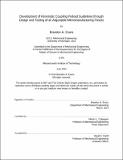| dc.contributor.advisor | Martin L. Culpepper. | en_US |
| dc.contributor.author | Evans, Brandon A. (Brandon Adam) | en_US |
| dc.contributor.other | Massachusetts Institute of Technology. Department of Mechanical Engineering. | en_US |
| dc.date.accessioned | 2014-12-08T18:09:20Z | |
| dc.date.available | 2014-12-08T18:09:20Z | |
| dc.date.copyright | 2014 | en_US |
| dc.date.issued | 2014 | en_US |
| dc.identifier.uri | http://hdl.handle.net/1721.1/92063 | |
| dc.description | Thesis: S.M., Massachusetts Institute of Technology, Department of Mechanical Engineering, 2014. | en_US |
| dc.description | This electronic version was submitted by the student author. The certified thesis is available in the Institute Archives and Special Collections. | en_US |
| dc.description | Cataloged from student-submitted PDF version of thesis. | en_US |
| dc.description | Includes bibliographical references (pages 111-117). | en_US |
| dc.description.abstract | In the growing field of non-lithographic micromanufacturing, the ability to properly align a workpiece to a machine limits the attainable tolerances in micro-electro-mechanical-systems (MEMS) prototyping. This limit has created the need for a standard adjustable base for implementation into multiple precision machines, allowing for six-axis adjustment and alignment of workpiece stages that are moved between these machines. Such a fixture--a hybrid positioning fixture (HPF)--has been designed, fabricated, and tested. This HPF has demonstrated <50 nm and <1.5 [mu]rad 2[sigma] (95% confidence) static positional repeatability over 1000 separation-engagement cycles and equivalent 2[sigma] (95% confidence) path-following accuracy when used as a dynamic nano-stage. The HPF has also demonstrated adequate stiffness to ensure <50 nm positional accuracy over an adjustment range of ±5 [mu]m and ±100 [mu]rad in response to 2 N normal and lateral forces during micro-milling operations. The HPF is based upon a kinematic coupling concept, and experiments have been completed that show highly repeatability coupling can be obtained by loading the Hertzian kinematic contacts of the HPF past the fully plastic half-groove material limit. This is a novel result that allows for stiffness increases of ~2.5 and load capacity increases of ~15.5 over conventional kinematic couplings, which are typically loaded to the sub-surface elastic limit. | en_US |
| dc.description.statementofresponsibility | by Brandon A. Evans. | en_US |
| dc.format.extent | 117 pages | en_US |
| dc.language.iso | eng | en_US |
| dc.publisher | Massachusetts Institute of Technology | en_US |
| dc.rights | M.I.T. theses are protected by copyright. They may be viewed from this source for any purpose, but reproduction or distribution in any format is prohibited without written permission. See provided URL for inquiries about permission. | en_US |
| dc.rights.uri | http://dspace.mit.edu/handle/1721.1/7582 | en_US |
| dc.subject | Mechanical Engineering. | en_US |
| dc.title | Development of kinematic coupling preload guidelines through design and testing of an adjustable micromanufacturing fixture | en_US |
| dc.type | Thesis | en_US |
| dc.description.degree | S.M. | en_US |
| dc.contributor.department | Massachusetts Institute of Technology. Department of Mechanical Engineering | |
| dc.identifier.oclc | 896821552 | en_US |
